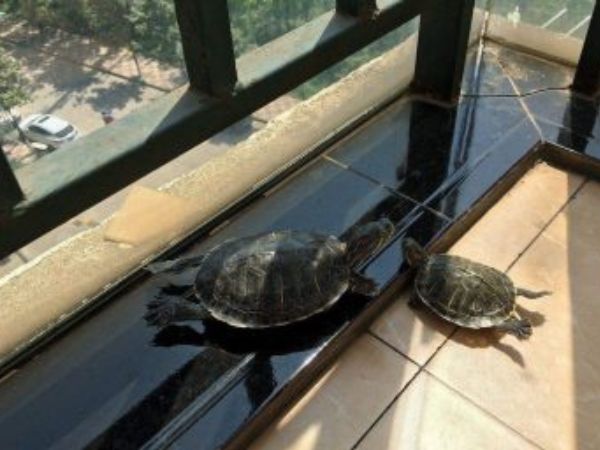How Do Turtles Sleep | A How-to Guide For Beginners
Turtles are one of the oldest animals to develop through the evolutionary period. In the process, turtles have developed a wide range of species across the globe. While these species vary in size, weight, habitat, and appearance, there’s one common thing about all the turtle species- these animals are almost all sleepy and love to sleep.
But how do turtles sleep? It is evident that the turtle’s sleep is hugely different form us- the human being. Turtles’ sleep, according to Sciencing, is mostly a resting state. Did you know that? I guess not.
[amazon box=”B01N9HP5QI” grid=”1″ price=”none”]
But that’s not all. There’re some even more interesting facts about the way a turtle sleeps. If you want to know them, read the article.
How Do Turtles Sleep
Where Do Turtles Sleep?
As we are all set to know the turtle’s sleeping habits, it’s almost preeminent to know about the sleeping place of this precious species. So, let’s take a look at the resting or sleeping place of different types of turtles.
Marine Turtles:
While staying far from the ocean line and deep into the sea, marine or sea turtles can sleep on the water’s surface on a floating state. But when it is in shallow water, the turtle will stick it beneath a coral outcropping or rock to sleep. As they sleep, their metabolic system slows down significantly to increase the efficiency of oxygen use for a sound sleep.
Freshwater Turtle:
There’re a number of turtle species found in freshwater, and each has distinctive sleeping habitat. For instance, Painted turtles like to bury themselves underneath the mud or sand at the bottom of the pond.
On the contrary, Map turtle, (a sub-species of aquatic turtle) dig themselves entirely or partially in the grass or moss-covered marshy area. Furthermore, snapping turtles will hibernate in any suitable place such as mud, submerged logs, or shallow water.
Desert Turtles:
Desert tortoise or turtle likes to sleep underneath sandy areas. They create a home to safeguard themselves from the extreme heat of the desert. Also, they don’t hibernate, likewise the other species living in cold areas.
Box Tortoises:
For snoozing and long hibernation box turtles love to place themselves beneath the leaf litter. Researchers found that box turtles make their home during a rainstorm when the mud or soil gets softened. It enables them to dig their burrow easily.
When and How Long Does a Turtle Sleep?
Wild turtles follow a definitive sleeping pattern that depends on their habitation. For instance, ocean turtles and also turtles living in cold areas will hibernate throughout the winter to accommodate the lowering temperature. On the other hand, turtles living in moderate to high-temperature regions will be less likely to hibernate.
Nonetheless, turtle lovers and owners across the globe keep flaunting the question- how much a turtle needs to sleep? Is my turtle oversleeping?
Before we dig deep into these popular questions, let’s admit the fact- turtles like to sleep cats likewise. But then again, oversleeping might be a sign that your turtle is sick.
In general, turtles are nocturnal, and so will sleep for most of the day. They do it to avoid the larger predators lurking around their habitats at day time. But pet turtles seem to have dramatically changed their nocturnal habit to a diurnal one. It means that domesticated turtles will remain active in the daytime and sleep at night.
But why do pet turtles change their sleeping habitat? The reasons are as followed:
- Owners fed the turtle mostly in the daytime.
- During the daytime, people keep coming in the room which disturbed the tortoises’ regular sleeping cycle.
- The indoor environment remains more active and stimulating in the daytime because of noise and lights.
Also, note that baby turtles are more active than the old ones, so, these will sleep less than their parents. So, if you see your baby turtle sleeping too much, we would recommend you to consult a veterinarian immediately.
Now, let’s come to the focal point of the conversion, what are the most appropriate sleeping hours for turtles? In general, domesticated turtles will sleep around 3-5 hours a day whereas; some wild ones such as the Giant Galapagos Turtle may sleep up to 16-18 hours a day.
But, in winter, the sleeping hours of pet turtles will increase significantly. To know why this happens, read the following part.
[amazon box=”B000BNQC58″ grid=”1″ price=”none”]
Why Do Turtles Hibernate/Sleep Long in Winter?
As winter closes in, water temperature falls drastically. So, turtle finds it hard to adjust to the falling temperature since they are cold-blooded species. So, to evade the danger of getting their blood freezing in extreme cold, they would go to brumation.
Brumation also means hibernation, where the turtle slows down its metabolism to avoid severe effects. And this is true for pet turtles even. If they notice any temperature fall in the water, they will consider it a sign of winter advancing in and so will initiate its hibernation process.
So, in winter, you may place your turtle home near a fireplace so that it doesn’t get affected by the outside cold. Furthermore, if you notice your turtle sleeping too much, check the water temperature to see whether it feels cold or not.
Recommendation For The Water Temperature of The Popular Turtle Types
Now that you know how, where, and when turtles sleep, the next thing you might be interested to know is the appropriate temperature for your home turtle. It will ensure that your loving pet gets a cozy environment for sleeping.
So, let’s check the facts.
- Painted turtles are comfortable at 75-82°F temperature.
- Red-eared Sliders will feel at home at 76-84°F temperature.
- Asian Box tortoise will be comfy at 90°F.
So, use a standard thermometer to regularly check the water and room temperature so that your turtle enjoys the environment.
Conclusion:
Although the sleeping habit differs greatly from one species to another for turtles, pet tortoise follows a familiar pattern. These will sleep about 4-6 hours per night and remain active in the daytime. Also, they will find a safe place to protects themselves from larger predators when they sleep.
This is also common among domesticated turtles since mostly they came from the wild or past few days in captivation before arriving home. Lastly, we recommend you prepare a cozy sleeping environment for turtles with adequate space and proper heating.




